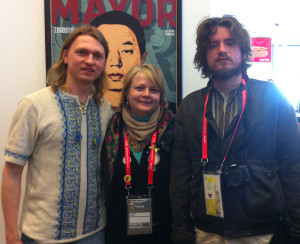As an Official Selection for the 2015 Sundance Film Festival, The Russian Woodpecker description in the film catalog reads– A Ukrainian victim of the Chernobyl nuclear disaster discovers a dark secret and must decide whether to risk his life by revealing it, amid growing clouds of revolution and war. World Premiere at 2015 Sundance Film Festival — World Cinema Documentary Competition. That is only the beginning.
Fedir Alexandrovich, artist, pacifist, humanitarian, became a Chernobyl “orphan” by age 4, taken from his parents out of the radiation hot zone where he and his family lived. He grew up thinking– how could such a tragic event affecting millions of people worldwide and future generations be an “accident” and who is responsible? Until now, there have been no answers, investigation and documents are missing, incomplete, or classified. There was no cooperation with international scientists to study what had happened to make sure it doesn’t happen again. A seemingly innocuous account by a friend’s father, an airplane pilot at the time flying over the radioactive cloud, suggested that there was something else going on under the cloud, a pyramid of some sort emitting a bluish light directly across from Reactor Number 4. It was enough for Fedir, considered by some friends a frenetic artsy fool, while others, especially his friend and cinematographer, Artem Ryzhykov, believe he is an artistic genius.
An artist’s mind is wired differently. Whenever someone asks an artist, musician or filmmaker to interpret their work, the answer is often “whatever you get out of this.” They only need an iota, a trace, a fragment to trigger a visualization of disparate objects. Bits and pieces of imagery, color, sounds become intertwined with everyday existence creating the viewer’s map of discovery. When one such bit of information– however unlikely to be of any importance– is rooted in a creative mind, it doesn’t take much (a conversation, a witness, a sentence, an anecdote, an offhand remark) to turn it into a “Eureka” or an “Aha” moment. Just as Dr. Watson accompanies, challenges and interprets Sherlock Holmes into the labyrinths of deductive reasoning and discovery, so does Artem, who follows Fedir with his camera leading into resistance, dead ends, brickwalls, and eventually the line of fire. Brilliantly shot, the boldness sometimes goes undercover to capture the trail of testimony with great personal risk of reprisals.
According to a global security website, the transmitter “Duga” was an experimental over-the-horizon radar, designed in 1970. The signal is pulse-modulated at a rate of several times a second [most sources state 10 pulses per second], sounding like a woodpecker and dubbed the “Russian Woodpecker.” Initial tests were achieved for a middle-latitude route and in a relatively quiet ionosphere and so, it started pulsating on July 4, 1976. The transmitter interfered with several communications channels, including emergency frequencies for aircraft on transoceanic flights. Theories extended to suggestions the Soviets were trying to modify the weather or experimenting with radio waves to control human behavior and according to some scientific studies, these radio waves have been associated with affecting the human brain. However, the Aurora Borealis induces substantial fluctuations in ionospheric properties that prevented the radio waves from going over the horizon and penetrating North American territories. At a cost of 9 billion rubles, it essentially became worthless technology for the Soviets.
Information from an online source states that the Chernobyl Nuclear Power plant was under the direct jurisdiction of the central authorities of the Soviet Union. When a sudden and unexpected power surge happened during a test on Saturday, April 26, 1986, an emergency shutdown was attempted, but then an exponentially larger spike in power output occurred, which led to a reactor vessel rupture and a series of steam explosions. The explosion and fire released large quantities of radioactive particles into the atmosphere, spreading over much of the western USSR and Europe. Containing the contamination ultimately involved over 500,000 workers and cost an estimated 18 billion rubles. Long-term effects such as cancers are still unknown for future generations.
Personal statements and substantial corroboration supports a credible theory that a call came from Moscow ordering the Chernobyl nuclear tragedy. Ultimately, it was a bureaucrat’s decision to save his career that precipitated into this unimaginable crime against the natural world and humanity.
Coming from the UK, an accomplished documentary filmmaker and renaissance man, Chad Gracia, (checkout his repository of digital artifacts) directed and edited this remarkable story interweaving archival footage with art and then connecting it all to the events on the Maidan in Kyiv. Ukraine may be the last bastion against a world tyrant who resurrected the USSR and with a personal vendetta against the United States and the European Union, fundamentally an undeclared Holy War against Western civilization. At the end of the world premiere screening, there was a standing ovation for this cautionary tale. In a way, it is a Russian woodpecker that is sounding an alarm.
The Russian Woodpecker won the World Cinema Grand Jury Prize at Sundance Film Festival 2015.




05/10/2015 at 2:25 pm
Excellent review. I discovered your website while looking for more information about this film – what and interesting site and what a fun job you have.
Last night I attended a panel discussion wherein both Fedor and Artem (both pictured in your review) participated. I was blown away by how well formulated their ideas were and how comprehensive their thinking was on both Ukrainian and world politics. And as I watched for some reason George Clooney came to mind and I pictured the interview where he wore a T-shirt that said Free Yulia and it reminded how much our “American Ambassadors” lack any real understanding of the issues.
Thank you for sharing this.
Best,
Tamara